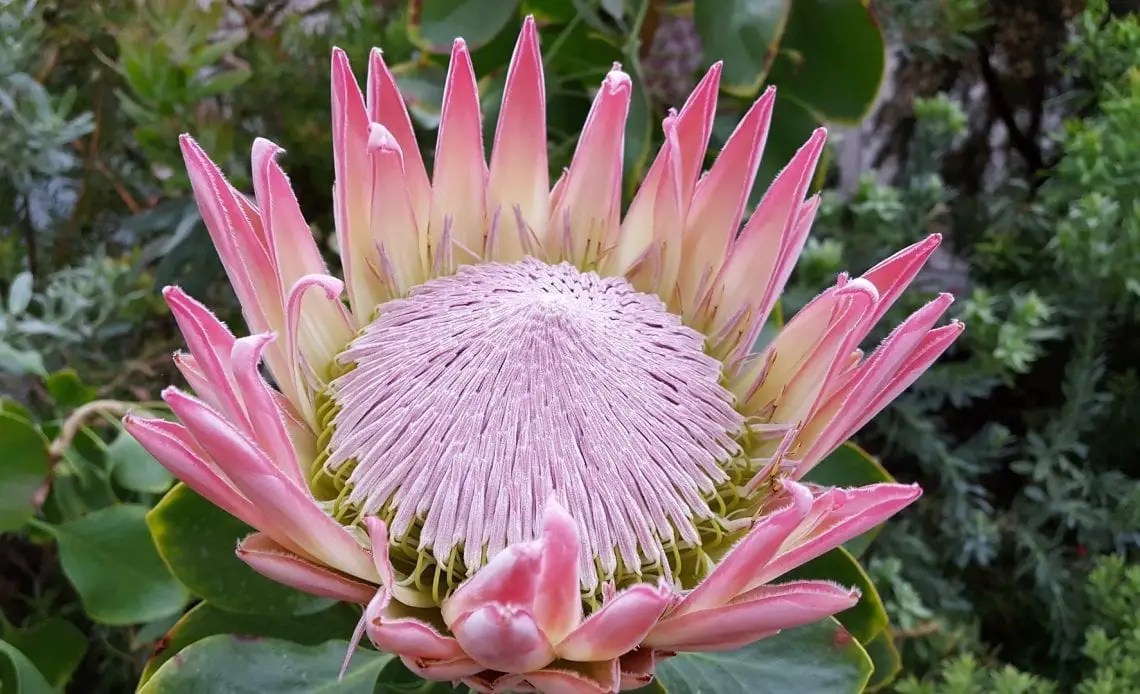
Last updated on May 22nd, 2023 at 12:10 am
The protea flower is one of the oldest flowers on Earth, dating back millions of years. It is a member of the Proteaceae family.
The largest and most popular protea species is king protea (Protea cynaroides), also known as giant protea, king protea, and king sugar bush. The flower resembles an artichoke, a fact reflected in its specific scientific name, cynaroides, meaning ‘like central (globe artichoke). This flower has an astonishing number of varieties within its family. It comes in different shapes, sizes, hues, and textures, making up over a thousand species.
The genus protea is one of the oldest families of flowering plants. They are considered to date back about 300 million years. They have cluster roots, solitary ovules, and indehiscent fruits. They are native to the southwestern and southern parts of South Africa, mostly found in the Cape Floristic region of South Africa.
Protea was named and classified in 1735 by Carl Linnaeus, the Swedish botanist, and father of modern taxonomy. He gave the Proteaceae family its name after the Greek deity Proteus. A primordial god of the seas, Proteus personifies the elusive nature of the ever-changing nature of the sea. Linnaeus saw resonance between this mythical idea of a shape-shifting divinity and the enormous diversity of form within this plant family, which comprises over 1500 species.
What does the Protea flower symbolize?
Dictionaries define ‘protean’ as flexible, adaptable, versatile, diverse, and able to change easily and frequently—protea flowers have all these properties. They come in many colors, hues, textures, and shapes. They thrive in extreme geographical and weather conditions. Finally, proteas dominate with their size and sturdiness. That such a flower is named after a god seems fully befitting.
In a way, the protea flower is the first of its kind. Based on fossil findings, scientists have established that the proteas are among the oldest flowering plants on the planet. Proteas first appeared on the ancient supercontinent Gondwanaland nearly 300 million years ago—the king protea being one of the oldest flowering plants. Two known legends gave the king protea flower meaning and symbolism.
One legend comes from the land of South Africa. The South Africans were enticed by the unique shape of the flower’s petals. The petals reminded them of a crown. Hence, they named the flower King Protea.
The other legend comes from Greek mythology. Proteus, the son of Poseidon, could change his appearance at will. He also had another power to see the future. He was often sought out by people who wanted his prophecies. To avoid them, he frequently changed his form. The king protea flower, too, has many different shapes and sizes.
Proteus’ name comes from the Greek word ‘protos,’ which means ‘first.’ Proteus was the first son of the Greek god Poseidon and among the first divine figures mentioned in Greek mythology. Being first applies to the protea flower, too.
King protea flower’s meaning and symbolism are associated with change and transformation. It symbolizes diversity, courage, and uniqueness. It is a very unusual plant, quite different from other flowers. King protea teaches everyone to embrace a beauty that is different and unique. It tends to thrive in conditions where other plants normally die. Thus, the king protea flower symbolizes strength and longevity.
All in all, the protea flower symbolic meanings are:
- diversity
- courage
- resilience
- change
Meaning of the Protea flower colors
Red color
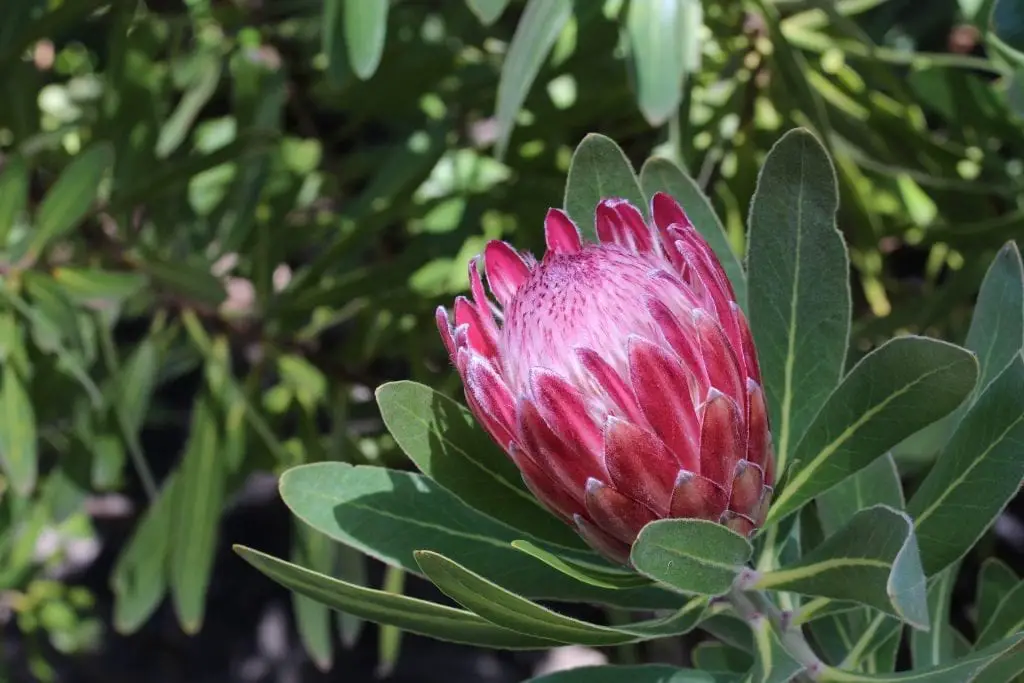
The red protea flower is a royal symbol of passion and romance. It symbolizes the courageous expression of love in its unique shape and extravagance.
Red is one of the primary colors of the king protea variety. Red king protea flowers symbolize passion, romance, love, marriage, seriousness, protection, wealth, growth, and good health.
The hybrid variety called ‘pink ice’ (Proteaceae Protea hybrid) is another popular protea flower with strong hues of red.
Pink color
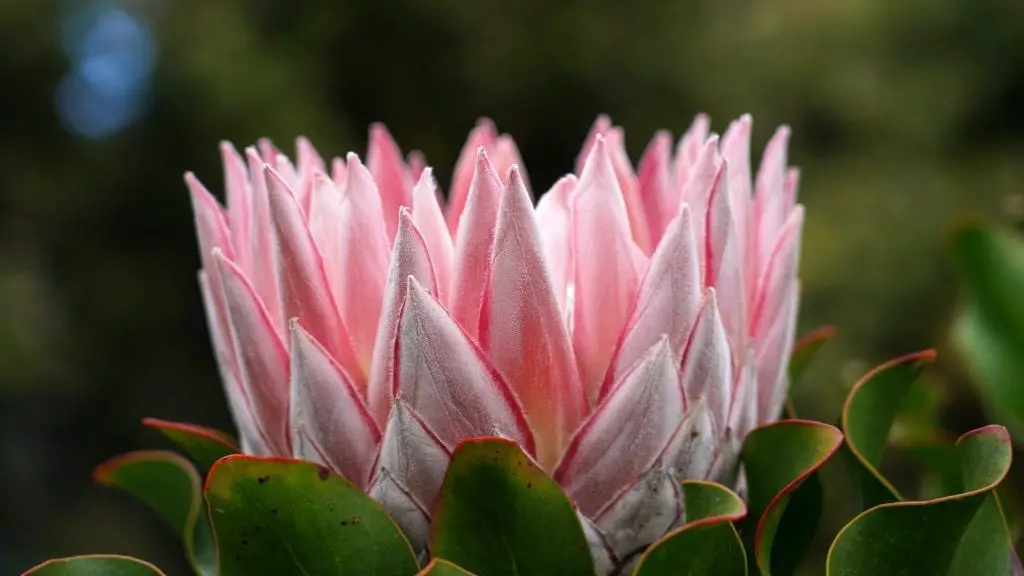
The pink protea flower represents the gentle aspects of first love, femininity, and motherly love.
Pink king protea flowers represent helpfulness, playfulness, platonic love, admiration, friendship, fun, joy, and development.
White color
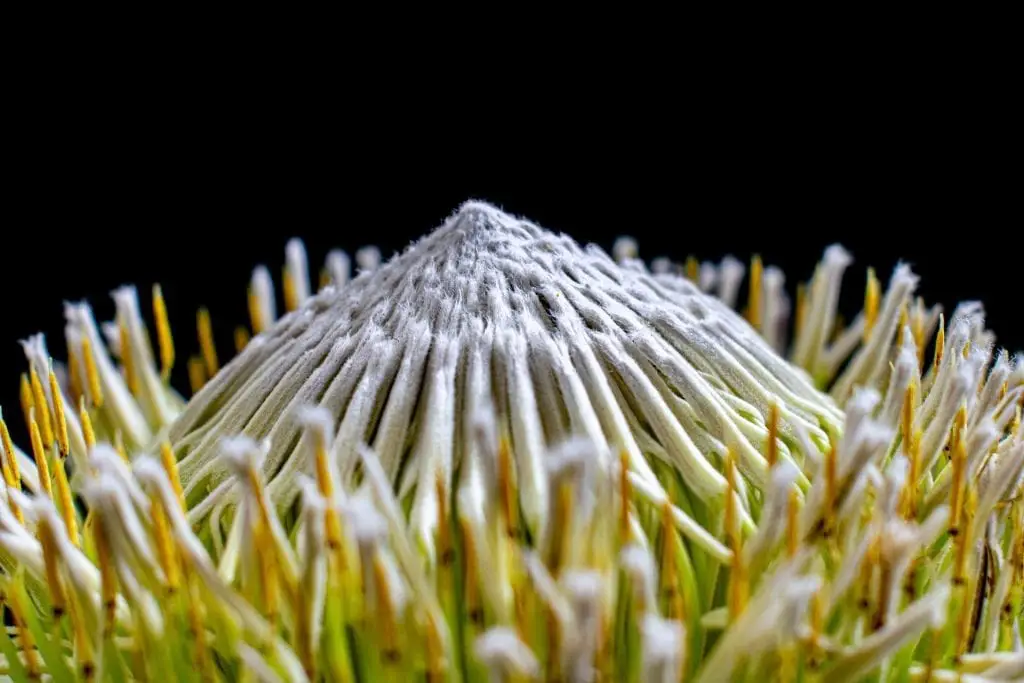
The white protea flower represents innocence, integrity of character, purity of intention, and honesty. This white flower communicates feelings of trust and sincerity and allows no duplicity or guile.
An interesting example of a white protea flower is Serruria Florida, a popular species from the family Proteaceae. Also known as ‘blushing bride,’ this plant has white flowers with a pinkish shade.
According to the old tradition of the French Huguenots, gifting a white protea flower to a woman was a symbolic way of proposing to her. Any man wearing a white protea flower on his lapel was making a public announcement to the town that he was now engaged.
White king protea flowers signify grief, new starts, innocence, healing, freshness, youth, and clarity.
Yellow/Orange color
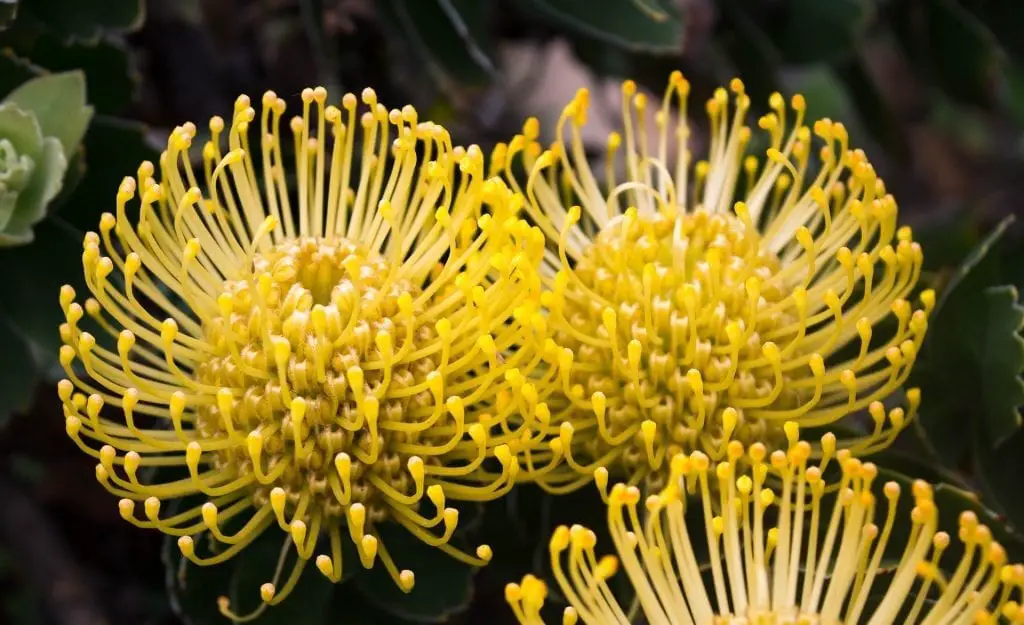
The yellow protea flower symbolizes honesty, trust, and compassion. The orange protea flower represents joyfulness, delight, cheerfulness, and an elevated state of being. Both yellow and orange proteas are symbols of spontaneous happiness and love for life.
Some varieties of the Pincushion protea (Leucospermum) have flowers in the shades of yellow and orange. The ‘skyrocket’ or ‘fireworks’ protea (Leucospermum reflexum var. luteum) also has yellow, fire-like flowers.
Green color
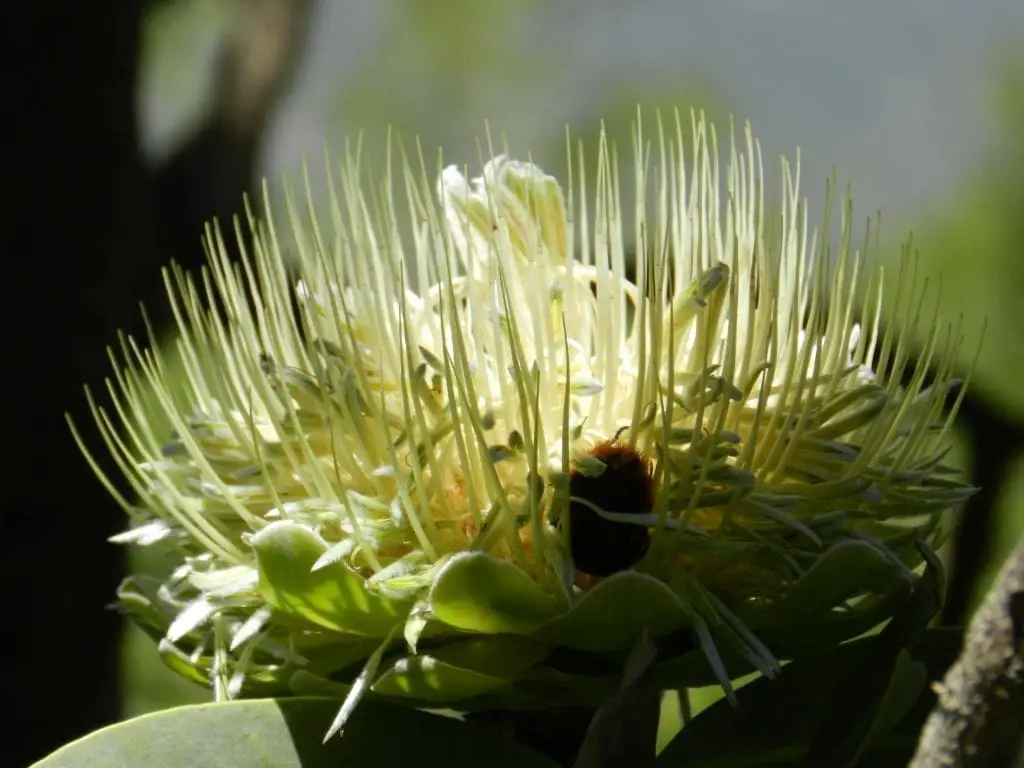
The green protea flower is perceived as a symbol of harmony, abundance, and good luck.
Among the green-colored protea flowers, one of the best-known is Protea coronata. It has an unusual apple-green flower head wrapped inside silvery foliage.
Another green-colored protea variety is the ‘bird’s nest’ (Banksia baxteri), which has a lovely lime-green bloom.
Purple color
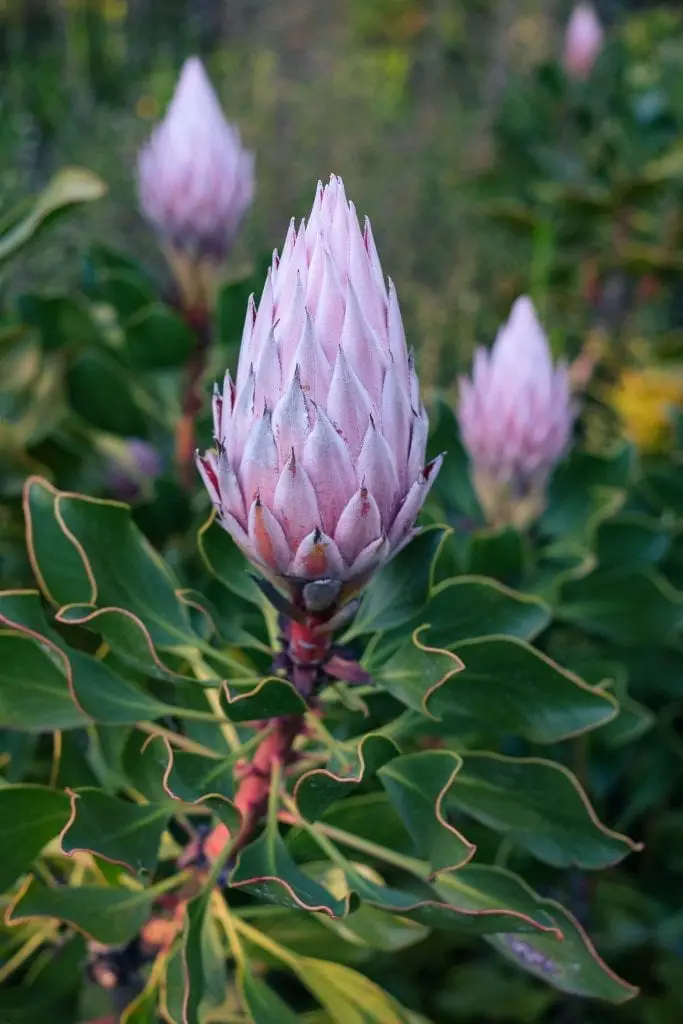
Purple is the color of royalty and spirituality. Therefore, the purple protea flower symbolizes grace, mystery, sovereignty, and class.
Interesting facts about the Protea flowers
- The protea flowers were introduced to Europe in the 1700s.
- The protea flowers are also called sugarbushes since they produce much nectar.
- The proteas have developed sclerophylly (a form of adaptation to extreme environmental and climate conditions). This property makes the leaves resistant to water loss.
- Insects (honey bees, scarab beetles, rove beetles), bats, small birds, and small marsupial mammals pollinate the protea flowers.
- Despite the large size of the protea flower heads, they produce a relatively small amount of seeds. Only up to 30 percent of the flowers generate a seed of sufficient genetic potential to propagate the species.
- Some protea species’ stems have been used as firewood and material for making furniture.
- The African species Protea nitida forms a large, 5 m tall tree. Baboons often climb these trees for a good lookout and to eat the nectar from the flowers. For this reason, this protea species is called ‘bobbejaan suikerbos’ in the local language.
- The protea flower’s nectar has long been used as a substitute for sugar. Protea’s syrupy nectar is extremely rich in sucrose and tastes like honey.
- Protea is a highly resilient plant that easily survives wildfires. Its thick underground stem (called lignotuber) contains many dormant buds that sprout quickly after the fire is extinguished. Certain chemicals in the smoke also support the process of germination. Furthermore, wildfires accelerate the cone drying and the seeds’ release. This plays a significant role in the propagation of the protea species.
- The protea plant absorbs all the water it requires from the fog, using the moisture that collects on its leaves’ surface.
- The oldest cultivation of proteas outside their native regions was recorded in the eighteenth century. The Englishman Joseph Knight succeeded in growing proteas under artificial conditions. His first cultivated protea flowers were displayed at the Royal Botanical Gardens at Kew in 1774. He later documented his work, and by 1810, as many as 21 species were grown in his gardens.
- A few protea varieties have been used in pharmacology as medicine to treat coughs, other respiratory conditions, digestive problems, and diarrhea.
- The beautiful protea flower has been featured in an episode of the 2017 South Korean television series ‘Queen of Mystery.’ In the context of this show, proteas are referred to as out-of-the-ordinary, charming, and luxurious flowers. The protagonist’s gift bouquets of protea flowers convey two messages — gratitude and ‘sending sweet love.’
- The flower head resembles the vegetable artichoke.
- The bulb of the plant is toxic to children. This plant can irritate the skin and cause pain in the mouth if consumed.
- Over 90 percent of all protea species are only found in the biodiversity hotspot of South Africa — an area referred to as Cape fynbos, meaning “fine bush” in Afrikaans. This is a narrow coastal belt along the Cape.
- About 120 of all African protea species are classified as endangered. The King protea plant is a challenge to breed.
- The King protea is the largest. This flower has thick stems reaching a height of 3 m (9.84 ft). It develops around 6 to 10 flower heads. The flower heads are dome-shaped, consisting of many tubular-shaped small flowers.
- King protea is the National flower of South Africa. This flower appears on South African passports and birth certificates. The 5-Rand coin of South Africa also has the king protea flower on it.
- A special tea is made from the leaves of the king protea plant.
How to grow Protea flowers
When you plant king proteas, don’t expect flowers the first year. They will bloom in the second season and are perennials, which means they will return throughout one season each year. Their flowering season is determined by the climate in which they grow, but they normally only bloom for a few weeks out of the year.
- Plant the king protea in very well-draining soil.
- Place the plant in a spot with full sun.
- Spread a mulch of leaves or bark away from the trunk.
- Water once a week.
How to care for Protea flowers
- Give the king protea average watering
- Fertilize once in spring.
- Trim the diseased, withered leaves once a month.
- Remove spent flower heads and most of the stem to allow new growth.
Best time to gift Protea flowers
Proteas are popular both as cut flowers, single or in bouquets. They also look impressive in various dried flower arrangements. They are popular in bridal bouquets and wedding decorations, always holding the central position when featured with other flowers.
Protea flowers are a popular gift choice for birthdays and special day celebrations—Christmas, Mother’s Day, and Father’s Day, to name a few.
Proteas are a wonderful felicitation gift on the occasion of job promotions, business achievements, and graduations. Due to the size and uniqueness of this flower, the message is clear: ‘You have made a great achievement!’
Gifting pink or red protea flowers is a great way to express admiration and love uniquely stylishly, sophisticated, and old-fashioned. Green proteas are believed to attract money and good fortune and could be a perfect gift to a friend joining a new office or starting a new business venture.
As a symbol of longevity, the protea flower is a thoughtful gift for an elderly person. With its ancient and impressive heritage, this flower honors the wisdom of the age.
King protea flowers symbolize courage and uniqueness. Gifting someone these flowers can convey a strong message of courage and transformation. One can give king protea flowers as a gift when someone is shifting to a better job or new location.
Conclusion
Protea is a flower that adapts to harsh conditions and turns adversity into an advantage. It symbolizes strength and resilience and can be gifted to a friend or a family member going through a difficult phase in life, representing a heartfelt expression of understanding, empathy, and support.
Above all else, proteas represent the idea of diversity. They make an excellent gift to someone who needs encouragement and support for being different and standing out against conformity.
If the protea flowers could speak, then ‘Dare to be yourself,’ ‘Dare to be different,’ and ‘Your uniqueness is your strength’ would be some of the messages they convey.
If you want to know and learn more about flowers, we at PansyMaiden can help you. Check out our fun, easy-to-read, and informative flower-related content that you will surely enjoy!
